Bulletin – October 1997 Small Business Lending[*]
- Download 52KB
These notes were prepared in response to a request from the House of Representatives Standing Committee on Financial Institutions and Public Administration for information on aspects of small business financing. The Committee sought the material in preparation for the Governor's forthcoming appearance before it, and it has made the Bank's response publicly available. An article on small business financing appeared in the Bulletin of April 1997.
Trends in Interest Rates and Fees
The reduction in inflation in Australia in the 1990s has allowed interest rates in the economy to come down significantly. Most interest rates, including those on bank loans for housing and for small and large business, are at their lowest for a quarter of a century or more (Graph 1). The fall in interest rates in the 1990s has been substantially larger than the fall in inflation. For example, the indicator rate for small business overdrafts has fallen from around 20 per cent at the start of the decade, to under 9 per cent at present, whereas inflation over that period has come down from around 7 per cent to 2 per cent.
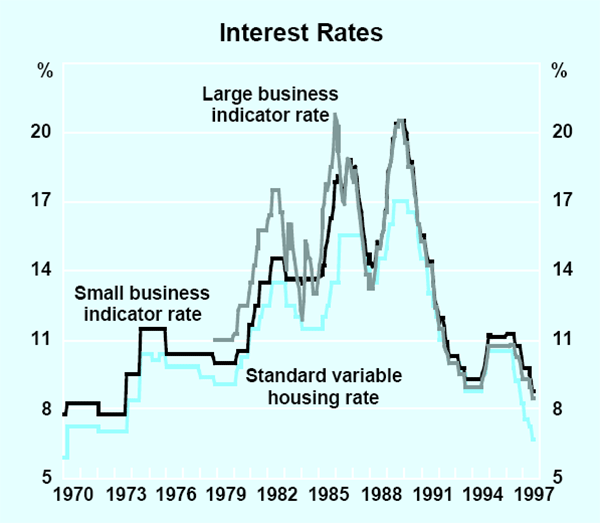
Banks provide three main types of loan facilities to businesses – variable-rate loans, fixed-rate loans and bill lines. In each case, the total interest rate charged comprises two components: an indicator rate, which banks vary from time to time (usually in response to changes in monetary policy) and a customer risk margin, which varies from customer to customer. Indicator rates are published by banks on a regular basis (usually weekly), but customer risk margins are not published because they are diverse and subject to negotiation between banks and their customers. However, in 1994 the Reserve Bank began a new interest rate collection for banks, from which this information can be derived. The analysis below describes not only what has been happening to indicator rates, but also to the total interest rates paid, including customer risk margins.
Indicator rates
Indicator rates on variable-rate loans (about 43 per cent of total small business loans at present) are set with reference to short-term money market interest rates, which are heavily influenced by the cash rate. These rates have fallen since mid 1996 as monetary policy has been eased. Since July 1996, the cash rate has been cut in five equal steps of half a percentage point – a total reduction of 2½ percentage points. These reductions have been passed on in full in the small business indicator rates for variable-rate loans. There are two main types of these loans – overdrafts and term loans – each of roughly equal importance. The indicator rate for overdrafts currently stands at 8.75 per cent, down from 11.25 per cent in mid 1996, while the indicator rate for term loans is at 6.8 per cent, down from 9.2 per cent.
In the case of fixed-rate loans (about 45 per cent of total loans), banks set indicator rates with reference to those on securities of comparable terms in capital markets. As it happens, over the past year these interest rates have fallen roughly by the same amount as the cash rate. Accordingly, the indicator rate on fixed-rate loans (say for a 3-year term) has also fallen by 2½ percentage points, to 7¼ per cent.
The indicator rate on bill lines (about 12 per cent of total loans) has also fallen by 2½ percentage points to a little under 5 per cent; this rate moves very closely with the cash rate.
Recent trends in each of these indicator rates are shown in Graph 2 and in Table 1.
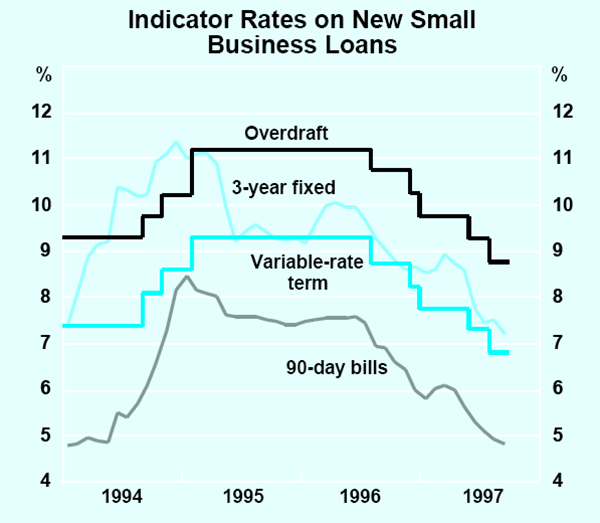
| Variable-rate loans |
3-year fixed-rate loans |
Bill lines (90 days) |
||
|---|---|---|---|---|
| Overdrafts | Term loans | |||
| July 96 | 11.25 | 9.2 | 9.7 | 7.4 |
| Aug 96 | 10.75 | 8.9 | 9.2 | 6.9 |
| Sep 96 | 10.75 | 8.7 | 9.0 | 6.9 |
| Oct 96 | 10.75 | 8.7 | 8.7 | 6.6 |
| Nov 96 | 10.75 | 8.7 | 8.5 | 6.4 |
| Dec 96 | 10.25 | 8.2 | 8.6 | 6.0 |
| Jan 97 | 9.75 | 7.7 | 8.5 | 5.8 |
| Feb 97 | 9.75 | 7.7 | 8.6 | 6.0 |
| Mar 97 | 9.75 | 7.7 | 8.9 | 6.1 |
| Apr 97 | 9.75 | 7.7 | 8.7 | 6.0 |
| May 97 | 9.75 | 7.7 | 8.6 | 5.6 |
| June 97 | 9.50 | 7.5 | 7.7 | 5.3 |
| July 97 | 9.25 | 7.3 | 7.4 | 5.1 |
| Aug 97 | 8.75 | 7.1 | 7.5 | 4.9 |
| Sep 97 | 8.75 | 6.8 | 7.2 | 4.8 |
Total interest rates paid
The Reserve Bank collects information on total interest rates paid on a quarterly basis, the latest figures available being for the June quarter 1997. The figures measure the average interest rates paid on all outstanding loans to small businesses, not just new loans.
Table 2 shows, for each type of small business loan, details of the overall interest rates paid, split into the indicator rate component and the average customer risk margins:
- The total interest rate paid on variable-rate loans, on average, was 10.6 per cent at end June. These figures do not reflect the July easing of monetary policy. The Bank estimates that when the effects of this flow through, the average interest rate paid will fall to about 10.1 per cent by end September. This compares with 12.6 per cent in June 1996, before the easings began – i.e. the average interest rate paid on this type of facility, like the indicator rates, has fallen in line with the cash rate. In other words, there has been no movement in customer risk margins, which have been fairly steady in the past year at just under 2 percentage points.
- The average interest rate paid on fixed-rate loans was 9.8 per cent in the June quarter. The Bank estimates that this is likely to fall by another 0.2 of a percentage point in the September quarter as the impact of the recent falls in capital market interest rates feed into new fixed-rate loans. This would bring the total fall since mid 1996 to about one percentage point, a fall which is less than that in variable-rate loans because existing borrowers of fixed-rate money do not benefit if interest rates fall after their loan was taken out; they need to wait until the loan is renewed. The typical term for fixed-rate loans is between 3 and 5 years, so changes in market rates show up only gradually in the average interest rate paid. Customer risk margins, like those on variable-rate loans, have been fairly steady, at just under 2 percentage points.
- The average interest rate paid on bill finance was 8.6 per cent in the June quarter, and is estimated to have fallen to a little over 8 per cent in the September quarter; again this is down by a similar amount to the cash rate since mid 1996. Customer risk margins have been steady. Margins on bill finance look higher than on other loans because they also incorporate fees (see next section).
Measured across all types of loan facilities, the average interest rate paid by small businesses was 10 per cent at end June 1997. When the effects of the July easing are fully reflected, this should fall to around 9.7 per cent, a fall of a little under 2 percentage points since mid 1996. This fall is less than the fall in cash rates due to the impact of fixed-rate loans mentioned above.
Not all businesses, of course, pay the average interest rate. Graph 3 shows the distribution of rates paid at end June 1997. The range is quite wide, with a significant proportion paying as little as 7 per cent, and others as much as 13 per cent. The most common interest rate paid was between 9 and 10 per cent. The distribution of interest rates shown in Graph 3 will move to the left in the September quarter as the July easing affects the statistics – i.e. more businesses will be paying lower rates.
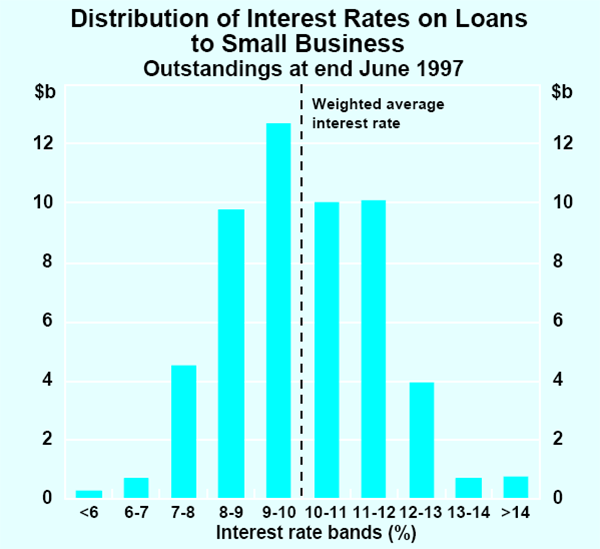
Fees
In addition to interest rates, banks also charge fees for establishing and administering loans. The size and nature of fees vary greatly among banks, making it difficult to draw precise conclusions about trends. However, by making some assumptions about the size and maturity of loans, it is possible to express fees as an annual interest rate equivalent. On variable-rate loans, we estimate that fees on average amount to about 0.8 per cent per annum, and have not changed much in recent years. For fixed-rate loans, the average fee may be a little less, at around 0.5 per cent per annum. As noted, in the case of bill lines, fees are included in customer risk margins, and in total amount to about 2.8 per cent per annum. Table 3 below summarises, for each type of small business loan, the interest rates and fees that applied as of June 1997.
|
Average indicator rate |
Customer risk margin |
Total interest rate |
Fees |
Total cost |
|
|---|---|---|---|---|---|
| Variable-rate loans | 8.7 | 1.9 | 10.6 | 0.8 | 11.4 |
| Fixed-rate loans | 7.9 | 1.9 | 9.8 | 0.5 | 10.3 |
| Bill finance | 5.8 | 2.8 | 8.6 | n.a(a) | 8.6 |
| Total loans | 8.1 | 1.9 | 10.0 | 0.6 | 10.6 |
| (a) Included in customer risk margin | |||||
Comprehensive information on loan fees charged by banks in other countries is not available. However, based on the Bank of England's Finance for Small Firms report (January 1997), and liaison from a selection of banks in several countries, it appears that the following points can be made:
- UK banks seem to charge higher establishment fees than banks in Australia, although some UK banks appear not to charge on-going administration fees. The Bank of England noted in its report on Finance for Small Firms that, while carded bank charges in general fell over 1996, the previous practice of negotiating some discount for customer s seemed to diminish, so it is not clear what the trend in fees actually paid has been.
- In Canada, most facilities attract an establishment fee of under 0.5 per cent, though in some cases they range up to 2 per cent. No information is available on administration fees.
- Establishment fees charged in New Zealand are generally 1 per cent for both term loans and overdrafts. An administrative fee of up to around 1½ per cent per annum applies to overdrafts, while term loans are generally free of this charge.
Lags in passing on changes in monetary policy
The extent to which small businesses benefit from cuts in the cash rate partly depends on how quickly these cuts are passed on by banks. For new borrowers, changes in interest rates take effect more or less immediately. But, for existing borrowers, there can be substantial lags involved, as has been the case during the past year. While responses varied from bank to bank and from episode to episode, rate reductions since July 1996 have been passed through to small businesses with an average lag of 35 days. This delay was much longer than was the case when policy was tightened in 1994, when the average lag was about 16 days (Table 4).
|
Easings 1990–93 |
Tightenings 1994 |
Easings 1996–97 |
|
|---|---|---|---|
| Small business indicator rate | 23 | 16 | 35 |
| Large business indicator rate | 18 | 16 | 21 |
| Housing indicator rate | 32 | 16 | 51 |
Impact of Competition on Banks' Provision of Small Business Finance
Until recently, competition in financing had been focused mainly in the housing loan market, but there are now signs of growing competition in small business finance. There are a couple of reasons for this. First, with margins in housing finance having been reduced substantially, banks are looking to increase market share in other areas. This is particularly so for ‘regional’ banks which traditionally had focused heavily on the housing market. Second, some mortgage managers have entered the market for lending to small business, although with mixed success and so far remain a small part of the market. Banks' response to date has been similar to their initial response to the entry of mortgage managers into the housing finance market. This was to compete ‘at the margin’ by introducing new products rather than cutting the price of existing products. The new products for small businesses are generally secured against residential property and are offered at a discount of around 2 percentage points to the standard overdraft rate.
A number of banks have also made available loans to small business against their expected cash flow or using other assets as collateral (e.g. plant and equipment, inventories, or receivables). These types of loans are priced to reflect the higher risk of securing against assets other than property. Partly reflecting higher interest rates, banks report limited interest in these products.
Growing competition might, over time, produce some compression of margins on small business loans. The margin between the cash rate and the average rate paid by small businesses on variable-rate loans is currently around 5 percentage points, a level which has not changed much since early 1995 (Table 5). In contrast, over the same period, the margin between the cash rate and housing loan rates has fallen from 3 percentage points to 1.7 percentage points.
Small business variable-rate loans |
Large business variable-rate loans |
Standard variable housing loans |
Credit cards (interest free period; annual fee) |
Personal instalment loans (variable secured) |
Personal instalment loans (variable unsecured) |
|
|---|---|---|---|---|---|---|
| Mar 95 | 5.1 | 3.3 | 3.0 | 9.2 | 3.9 | 5.4 |
| June 95 | 5.0 | 3.1 | 3.0 | 9.2 | 3.9 | 5.4 |
| Sep 95 | 5.0 | 3.1 | 3.0 | 9.2 | 3.9 | 5.4 |
| Dec 95 | 5.0 | 3.1 | 3.0 | 9.2 | 3.8 | 5.5 |
| Mar 96 | 5.1 | 3.1 | 3.0 | 9.2 | 4.0 | 6.0 |
| June 96 | 5.1 | 3.1 | 2.3 | 9.2 | 3.6 | 6.0 |
| Sep 96 | 5.0 | 3.2 | 2.3 | 9.7 | 3.9 | 6.5 |
| Dec 96 | 5.4 | 3.5 | 2.3 | 10.2 | 4.4 | 6.9 |
| Mar 97 | 4.9 | 3.4 | 1.6 | 10.0 | 4.0 | 6.6 |
| June 97 | 5.1 | 3.6 | 1.7 | 10.5 | 4.1 | 6.9 |
| Sep 97(a) | 5.1 | 3.6 | 1.7 | 10.3 | 4.3 | 7.4 |
| (a) Preliminary | ||||||
It seems unlikely that margins on lending to small businesses will fall to the same extent as those on owner-occupied housing. For one thing, banks have a substantial comparative advantage in lending to small business and competition from other providers will not be as intense as it has been in housing finance. Also, margins higher than for housing loans are justified because small business lending is, on average, considerably more risky and more costly than lending for housing.
Table 5 also compares margins on small business loans with those on various types of personal credit. Small business margins on variable-rate loans are wider than those on secured personal instalment credit, though narrower than on credit card loans and unsecured personal credit.
International comparisons of margins on small business loans are not readily available, as other countries do not appear to collect the same detailed information as is collected in Australia. There is, however, some fragmentary survey evidence available:
- The Bank of England's Finance for Small Firms report indicates that, in the United Kingdom, interest rates on small business loans on average were about 3–4 percentage points above the cash rate. These figures included both fixed-rate and variable-rate loans, so the figures may be affected by compositional factors which make comparison difficult. However, it does appear that the margins are lower than in Australia. As noted in Table 5, in Australia margins over the cash rate for variable-rate loans are around 5 percentage points. If the calculation were made across all types of small business loans, as appears to be the case for the UK data, it would be 4.75 percentage points.
- In the US, the Federal Reserve publishes a survey of rates paid on commercial and industrial loans made by banks. In May 1997, the Fed noted that the average rate for loans up to $1 million was between 9 and 10 per cent, implying a margin above the cash rate of 3½–4½ percentage points. Again, this suggests that margins relative to the cash rate are lower than in Australia.
Trends in the Volume of Bank Finance
Latest figures suggest that small business lending picked up in the June quarter (Graph 4), after tapering off in the latter half of last year. However, the growth rate remains relatively low, at 5 per cent. This rate is only about half the growth rate of total credit in the economy. Anecdotal evidence suggests that small businesses are still keen to reduce debt as much as possible, perhaps reflecting a continuing impact on their psychology of the early 1990s recession.
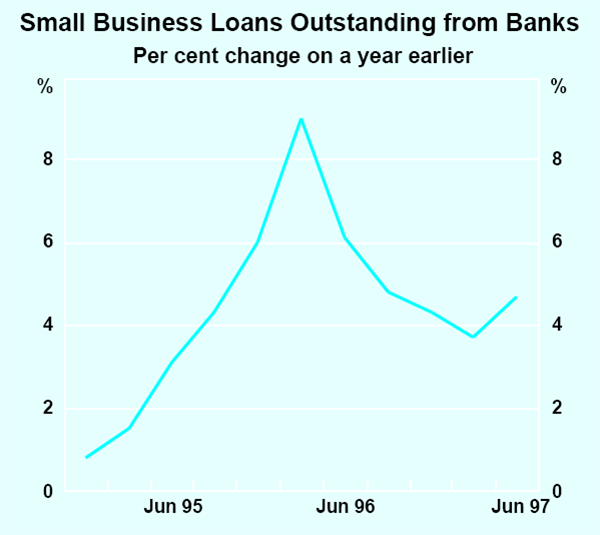
Lending approvals – a leading indicator of credit – have picked up in recent months indicating that there should be a further increase in the growth in credit to small businesses in coming months.
According to various surveys of small business, banks' provision of finance to small business has improved over recent years and is not a major concern for them. The latest Yellow Pages Survey of small business reports that only 2 per cent of small business identified lack of bank finance as a prime business concern.
Members of the Reserve Bank's Small Business Advisory Panel also report that they are generally content with both the availability of bank lending and current levels of interest rates. The one issue that has been raised is that small businesses are not getting as much access to bill finance as they would like. As noted in Table 3 above, bill finance is the cheapest form of finance, with an overall cost in June of 8.6 per cent, compared with 11.4 per cent for variable-rate loans and 10.3 per cent for fixed-rate loans. Despite this, use of bill finance by small businesses has fallen in recent years, to 12 per cent of total loans (Graph 5). The switch seems to have been into fixed-rate loans. While some of this may be due to small businesses wanting to lock in greater certainty on their borrowing costs, particularly as interest rates have fallen, it seems that a good part of it has been due to banks steering small business away from bill lines, apparently because they find it uneconomical to issue small lines of bills.
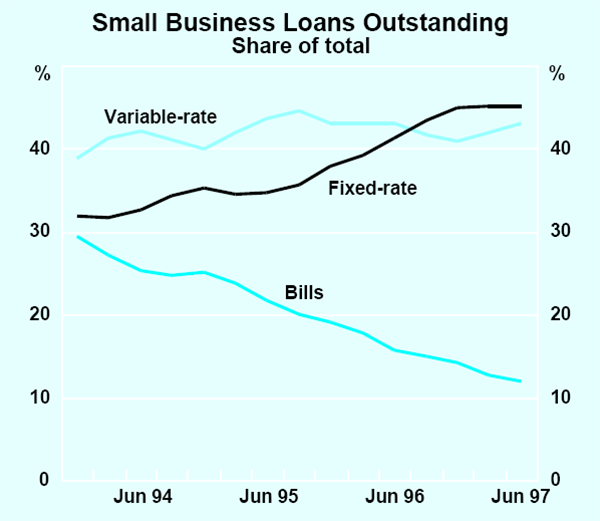
Equity Investments by Banks in Business
Only a small number of banks have taken advantage of the relaxation in policy aimed at facilitating their making modest equity investments in non-financial businesses. Most banks appear to be unattracted to this type of investment because of the greater risks involved and the potential for conflict of interest to arise where a bank is both an investor in and lender to a business. The few reported investments of this nature have tended to be in medium rather than small business. The Reserve Bank does not collect information on the returns to banks on such investments.
Footnote
Small business lending is defined as business loans of less than $500,000. [*]